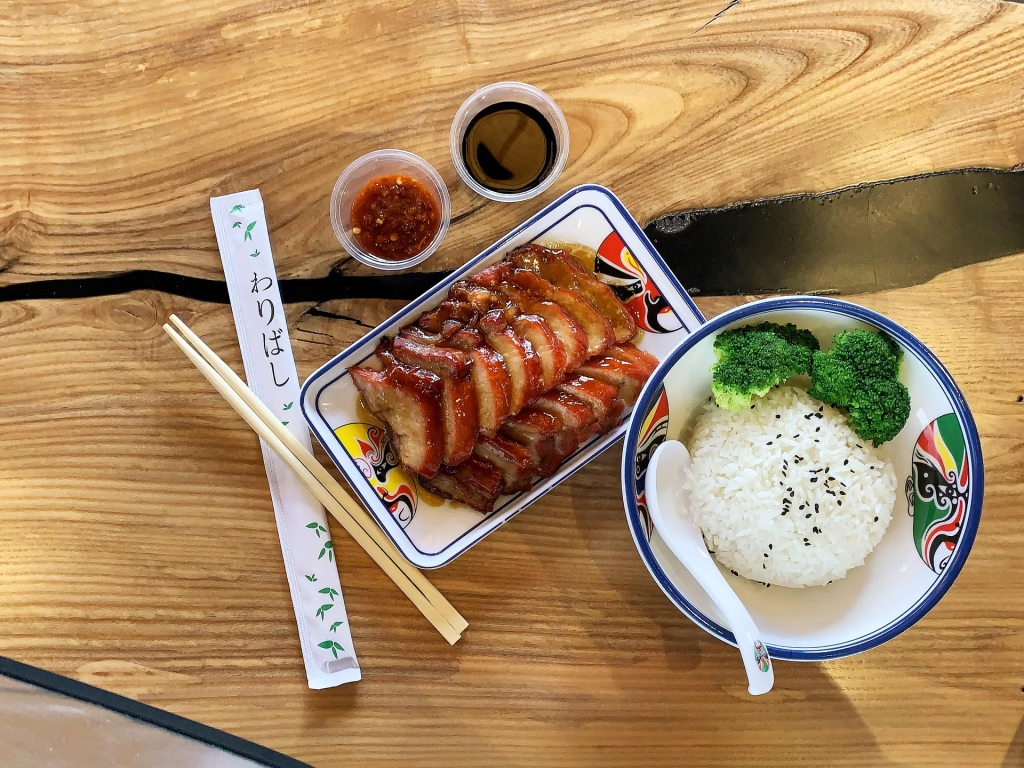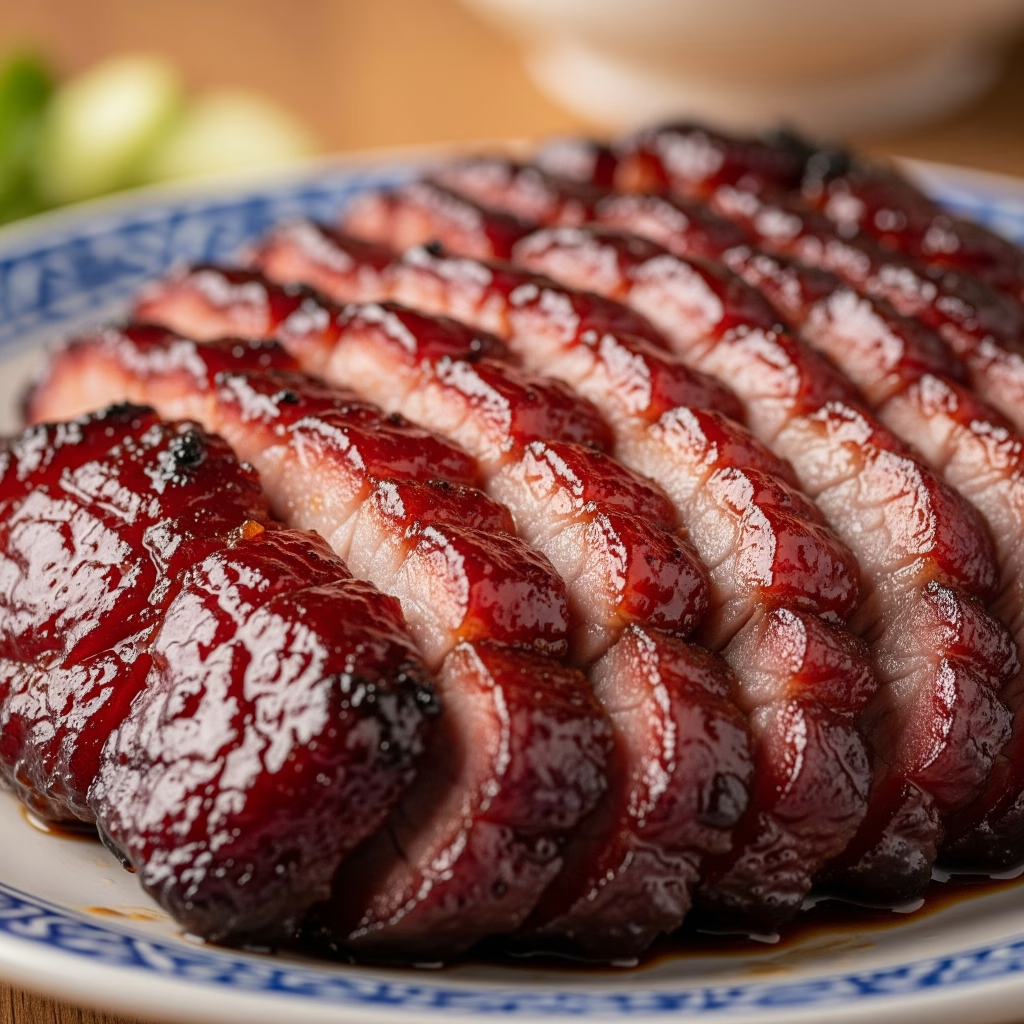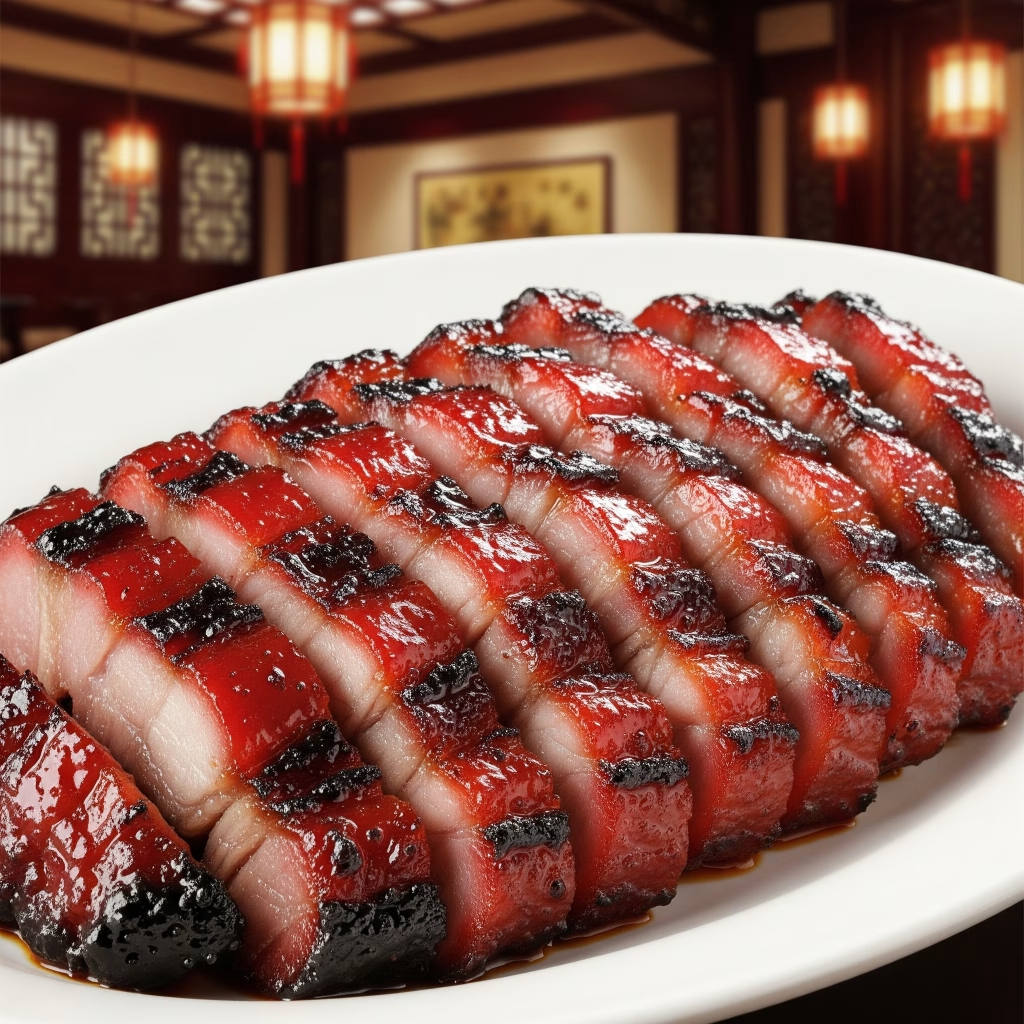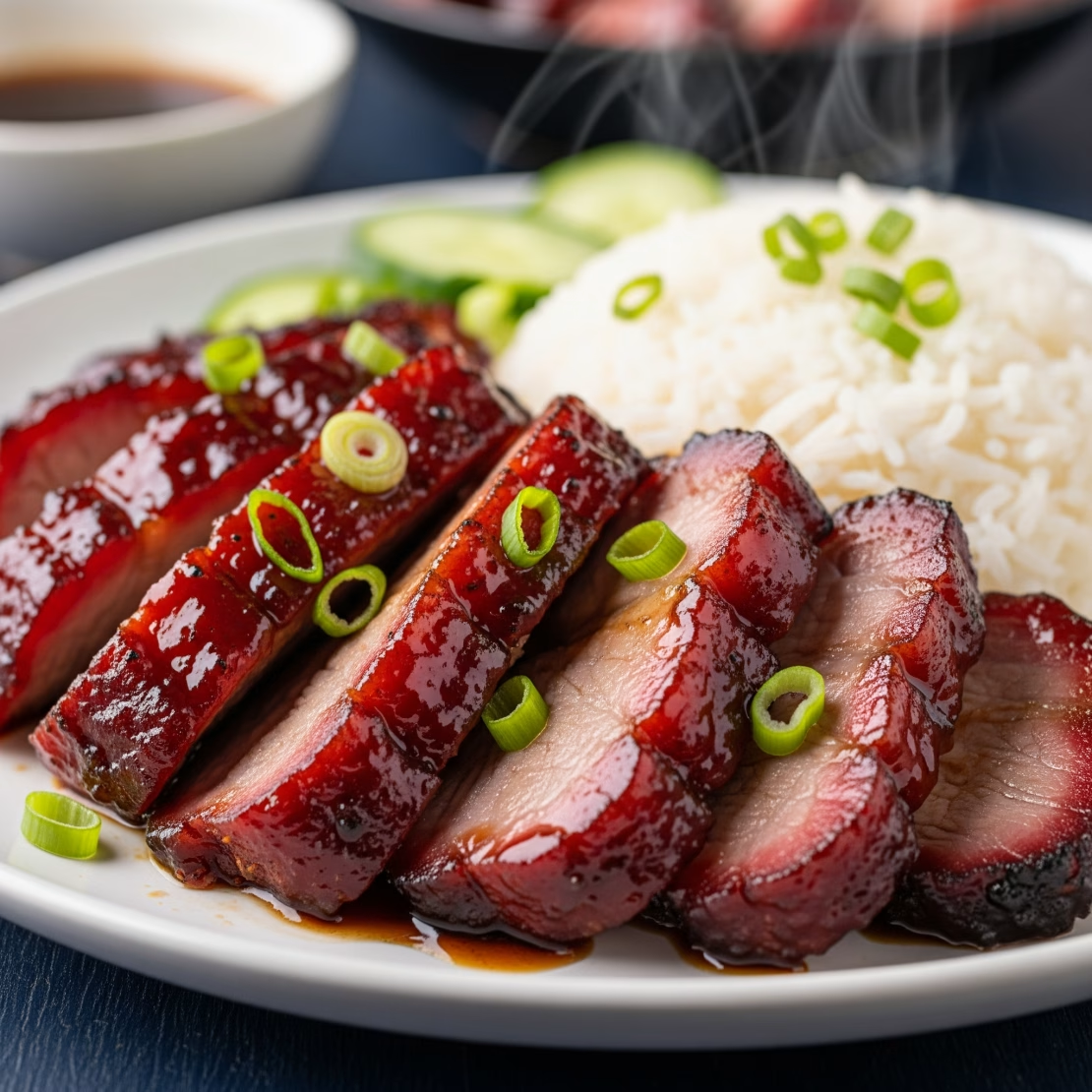Chinese Char Siu is a famous Cantonese dish known for its tender, flavorful pork, marinated in a sweet and savory sauce, and then roasted to perfection. The name “Char Siu” literally means “fork burn” in Cantonese, referring to the traditional method of roasting the pork on skewers over an open flame. The result is succulent, juicy pork with a slightly caramelized exterior that’s packed with flavor.
In this guide, we’ll walk you through making Char Siu at home, including step-by-step instructions, serving suggestions, tips, and everything you need to know about this iconic dish.
Table of Contents
Ingredients
For the Char Siu Marinade:
- 500 grams (1.1 lbs) pork shoulder or pork tenderloin, cut into long strips
- 2 tablespoons hoisin sauce
- 2 tablespoons soy sauce
- 2 tablespoons Chinese Shaoxing wine or dry sherry
- 1 tablespoon honey
- 1 tablespoon brown sugar or maltose (for an authentic touch)
- 1 teaspoon Chinese five-spice powder
- 1 teaspoon garlic, minced
- 1 teaspoon ginger, minced
- 1/2 teaspoon red food coloring (optional, for the characteristic red hue)
- 1/4 teaspoon salt
- 1/4 teaspoon white pepper
For the Glaze:
- 2 tablespoons honey
- 1 tablespoon soy sauce
- 1 tablespoon water
Serves
This recipe serves 4 people as part of a larger meal, with each serving consisting of a portion of char siu.
Step-by-Step Instructions
Step 1: Prepare the Marinade
- Mix the Marinade: In a mixing bowl, combine the hoisin sauce, soy sauce, Shaoxing wine, honey, brown sugar, Chinese five-spice powder, garlic, ginger, red food coloring (optional), salt, and white pepper. Stir until the sugar has dissolved and the marinade is smooth and well-combined.
- Marinate the Pork: Place the pork strips into the marinade and coat them evenly. Cover the bowl and refrigerate for at least 4 hours, but ideally overnight for the best flavor.
Step 2: Prepare the Glaze
- In a small saucepan, combine honey, soy sauce, and water. Stir over medium heat until the honey dissolves and the glaze is smooth.
- Let the glaze simmer for a few minutes until it thickens slightly. Remove from heat and set aside.
Step 3: Roast the Pork
- Preheat the Oven: Preheat your oven to 375°F (190°C). Line a baking sheet with aluminum foil or parchment paper for easy cleanup.
- Place the Pork on a Rack: Remove the pork from the marinade, reserving the marinade for basting. Place the pork on a wire rack set over the baking sheet. This will help the pork cook evenly and allow the glaze to caramelize.
- Roast the Pork: Roast the pork in the preheated oven for 25-30 minutes, turning the pork halfway through cooking to ensure it cooks evenly on all sides.
- Baste and Glaze: After the pork has roasted for about 15 minutes, brush a thin layer of the glaze over the pork. Continue roasting, basting every 10 minutes with more glaze, until the pork is cooked through and caramelized on the outside.
- Finish Roasting: When the pork has a beautifully caramelized exterior, remove it from the oven and let it rest for a few minutes before slicing.
Step 4: Serve
- Slice the roasted Char Siu into thin pieces, and serve on a platter. Drizzle with any leftover glaze or serve with a side of steamed rice or stir-fried vegetables.
Serving Suggestions
- With Steamed Rice: Serve Char Siu with a bowl of fluffy, steamed jasmine rice to balance the rich flavors of the pork.
- In a Bun: Use Char Siu in a traditional Chinese bao bun (steamed bun), filling the soft buns with sliced pork, cucumber, and hoisin sauce.
- Stir-Fry: Slice the char siu and use it as a protein in stir-fried noodles or vegetables.
- With Pickled Vegetables: The rich, savory pork pairs wonderfully with the tangy crunch of pickled vegetables, offering a perfect balance of flavors.
Tips for Perfect Char Siu
- Use Pork Shoulder for Juiciness: While pork tenderloin is lean and can be used, pork shoulder gives more flavor and juiciness due to its higher fat content.
- Marinate for Longer: The longer you marinate the pork, the more flavorful it will be. Aim for at least 4 hours, but ideally overnight.
- Don’t Skip the Glaze: The honey-soy glaze is crucial to achieving the caramelized, sticky finish that makes Char Siu so irresistible.
- Monitor the Oven: Keep an eye on the pork as it roasts. It can easily go from caramelized to burnt, so be sure to baste and turn the pork regularly.
- Use a Meat Thermometer: For perfectly cooked pork, use a meat thermometer. The pork should reach an internal temperature of 145°F (63°C).

Healthier Alternatives
- Use Lean Pork Cuts: If you want a leaner option, you can use pork tenderloin or lean pork loin instead of the fattier pork shoulder. Just be mindful that the meat will be slightly drier.
- Reduce the Sugar: You can reduce the amount of brown sugar and honey in the marinade for a healthier version of Char Siu.
- Grill Instead of Roast: For a smoky flavor, you can grill the pork instead of roasting it in the oven. Just be sure to baste the pork frequently to prevent it from drying out.
Creative Variations
- Add Spices: Experiment with additional spices like star anise, cinnamon, or cloves for a more complex flavor profile.
- Char Siu with Chicken: Substitute pork with chicken thighs for a different take on this classic recipe.
- Char Siu Bao: Make Char Siu Bao (BBQ pork buns) by using the roasted pork as a filling for soft steamed buns.
- Spicy Char Siu: Add chili paste or Sriracha to the marinade for a spicy kick that complements the sweetness of the sauce.

Common Mistakes to Avoid
- Not Marinating Long Enough: Marinating the pork for less than 4 hours means it won’t absorb the flavors of the sauce properly. For the best results, marinate overnight.
- Overcooking the Pork: Pork can dry out if overcooked. Make sure to check the internal temperature and avoid cooking it past 145°F (63°C).
- Not Basting Enough: The glaze is key to achieving that glossy, caramelized finish. Be sure to baste the pork every 10 minutes while roasting.
- Not Using a Rack: Don’t skip using a wire rack during roasting. This ensures the pork cooks evenly and allows the glaze to caramelize on all sides.
History of Char Siu
Char Siu, one of the quintessential dishes of Cantonese cuisine, has a long and rich history that dates back to the Tang Dynasty (618-907 AD). During this time, the Cantonese people began roasting meats over an open flame, creating the deliciously caramelized crust that Char Siu is known for. The dish was initially made with a variety of meats, but pork became the most common due to its availability and flavor.

The name “Char Siu” translates to “fork burn,” referencing the traditional method of skewering the pork on long forks and roasting it over an open flame. Over the years, the dish evolved into a staple of Cantonese cooking, especially in Hong Kong, where it is commonly served in restaurants and featured in a variety of dishes such as Char Siu Bao (BBQ pork buns) and Char Siu Noodles.
The marinade for Char Siu is what gives the dish its signature flavor, with a blend of hoisin sauce, soy sauce, five-spice powder, and sugar. These ingredients combine to create the perfect balance of sweet, salty, and savory flavors that make Char Siu so irresistible. Today, Char Siu is enjoyed around the world, both in its traditional form and in modern variations, continuing to be a beloved dish among food lovers of all cultures.
FAQs About Chinese Char Siu
1. Can I use other cuts of pork?
Yes, you can use pork loin or tenderloin, but pork shoulder is the most recommended due to its fattiness, which makes the meat more tender and juicy.
2. Can I make Char Siu ahead of time?
Yes, you can prepare the Char Siu and glaze it ahead of time. Just store the cooked pork in the refrigerator and reheat it before serving.
3. Is Char Siu spicy?
No, traditional Char Siu is not spicy. However, you can add chili paste to the marinade if you prefer a spicy version.
4. Can I make Char Siu without red food coloring?
Yes, the red food coloring is optional. It’s mainly used for aesthetic purposes to give the Char Siu its classic red hue.
5. Can I freeze Char Siu?
Yes, you can freeze cooked Char Siu. Just slice it, store it in an airtight container, and reheat when ready to serve.
6. What can I serve with Char Siu?
Char Siu is often served with steamed rice, bao buns, or in stir-fried dishes. It also pairs well with pickled vegetables.
7. How do I know when Char Siu is cooked?
Use a meat thermometer to check the internal temperature. It should reach 145°F (63°C) for safe consumption.
8. Can I grill Char Siu instead of roasting it?
Yes, you can grill Char Siu. Baste the pork frequently with the glaze while grilling over medium heat.
9. How long can I store Char Siu?
Cooked Char Siu can be stored in the refrigerator for up to 4 days or frozen for up to 1 month.
10. Can I use a slow cooker for Char Siu?
Yes, you can cook Char Siu in a slow cooker, but the texture won’t be as caramelized. It will still be tender and flavorful.
Chinese Char Siu (BBQ Pork) is a delectable dish that brings the flavors of Cantonese cuisine into your kitchen. With its tender, caramelized pork and rich, savory glaze, Char Siu is perfect for any occasion. Whether you serve it with rice, in bao buns, or as part of a larger meal, this dish is sure to impress. By following this recipe and using the tips provided, you’ll be able to create restaurant-quality Char Siu at home and enjoy a taste of authentic Chinese barbecue.


